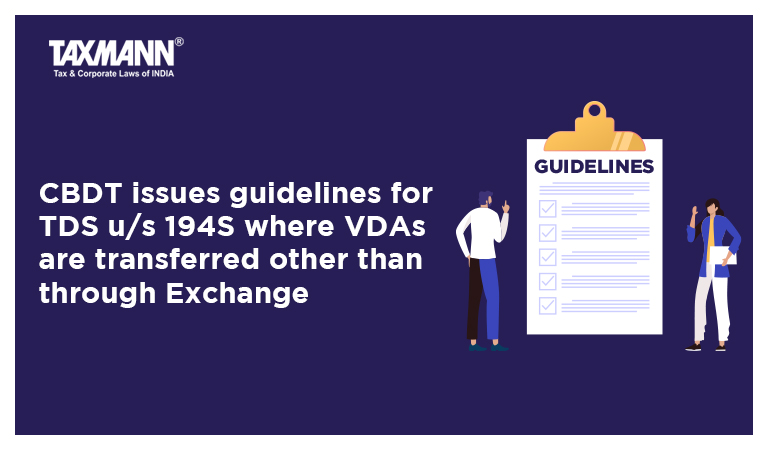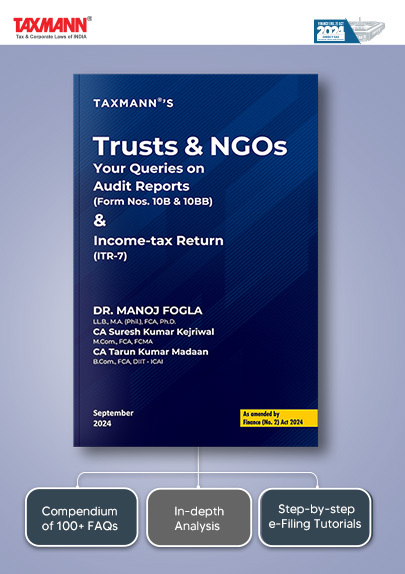CBDT issues guidelines for TDS u/s 194S where VDAs are transferred other than through Exchange
- Blog|News|Income Tax|
- 3 Min Read
- By Taxmann
- |
- Last Updated on 29 June, 2022
Circular No. 14/2022, dated 28-06-2022
The Finance Act 2022 inserted a new Section 194S to require deduction of tax by any person who is responsible for paying consideration to a resident person in respect of the transfer of virtual digital assets (VDAs).
It is to be noted that the liability to deduct tax under Section 194S is on a person responsible for paying the consideration for the transfer of VDA. In peer-to-peer transactions, the payer and buyer of the VDAs are generally the same. However, in the case of transactions through an Exchange, the payment is routed from the buyer (either directly or through a broker) to the seller through the Exchange and it is very much possible that the buyer and seller may not know each other. Thus, to remove the practical difficulties where VDAs are transferred through an Exchange, the CBDT issued guidelines to clarify the deduction of tax at source in such cases vide Circular No. 13, dated 22.06.2022.
Now, the CBDT has issued another Circular No. 14, dated 28-06-2022 to clarify the deduction of tax under section 194S in the case of peer-to-peer transactions. The CBDT has clarified the following aspect in this circular:
1. Who will be liable to deduct tax?
In a peer-to-peer transaction, the buyer (i.e., the person paying the consideration) is required to deduct tax under section 194S.
If the buyer is a non-specified person, the tax shall be deposited as per existing TDS provisions and the statement shall be filed in Form 26Q. Whereas, if the buyer is a specified person, the tax shall be deposited and the statement shall be filed through a challan-cum-statement in Form 26QE.
2. How to deduct tax if the consideration is in kind?
Where the consideration for transfer of VDA is in kind or partly in kind and cash is not sufficient to meet the TDS liability, the person responsible for paying such consideration is required to ensure that the tax required to be deducted has been paid in respect of such consideration, before releasing the consideration.
The liability in such cases may be discharged either by the payer by grossing up and paying tax out of his pocket or by the payee himself.
The CBDT has clarified that where the payee (i.e., seller) himself pays tax, the buyer will release the consideration in kind after the seller provides proof of payment of such tax, i.e., challan details, etc. This would be then required to be reported in the TDS statement along with the challan number. Form 26Q and Form 26QE have included provisions for reporting such transactions.
3. How to deduct tax in case of exchange of VDAs?
In the case of exchange of VDAs, the transfer of VDAs shall happen from both sides, i.e., the buyer as well as the seller. Thus, in such cases, both buyer and seller shall be liable to deduct tax at source.
For instance, where VDA “A” is being exchanged with another VDA “B”, both the persons are buyer as well as seller. One is buyer for “A” and seller for “B” and another is buyer for “B” and seller for “A”.
Thus, both need to pay tax with respect to transfer of VDA and show the evidence to other so that VDAs can then be exchanged. This would then be required to be reported in TDS statement along with challan number. Form 26Q and Form 26QE have included provisions for reporting such transactions.
4. Will the amount of consideration for transfer of VDA include GST?
The CBDT has clarified that the TDS shall be on consideration for transfer of VDA less GST.
5. Whether TDS under Section 194Q also be applicable on the transfer of VDA?
The CBDT has clarified that once tax is deducted under section 194S, tax would not be required to be deducted under Section 194Q.
Click Here To Read The Full Circular
Disclaimer: The content/information published on the website is only for general information of the user and shall not be construed as legal advice. While the Taxmann has exercised reasonable efforts to ensure the veracity of information/content published, Taxmann shall be under no liability in any manner whatsoever for incorrect information, if any.

Taxmann Publications has a dedicated in-house Research & Editorial Team. This team consists of a team of Chartered Accountants, Company Secretaries, and Lawyers. This team works under the guidance and supervision of editor-in-chief Mr Rakesh Bhargava.
The Research and Editorial Team is responsible for developing reliable and accurate content for the readers. The team follows the six-sigma approach to achieve the benchmark of zero error in its publications and research platforms. The team ensures that the following publication guidelines are thoroughly followed while developing the content:
- The statutory material is obtained only from the authorized and reliable sources
- All the latest developments in the judicial and legislative fields are covered
- Prepare the analytical write-ups on current, controversial, and important issues to help the readers to understand the concept and its implications
- Every content published by Taxmann is complete, accurate and lucid
- All evidence-based statements are supported with proper reference to Section, Circular No., Notification No. or citations
- The golden rules of grammar, style and consistency are thoroughly followed
- Font and size that’s easy to read and remain consistent across all imprint and digital publications are applied






 CA | CS | CMA
CA | CS | CMA


